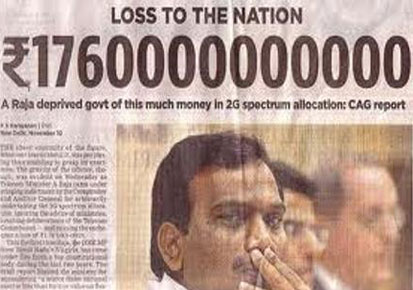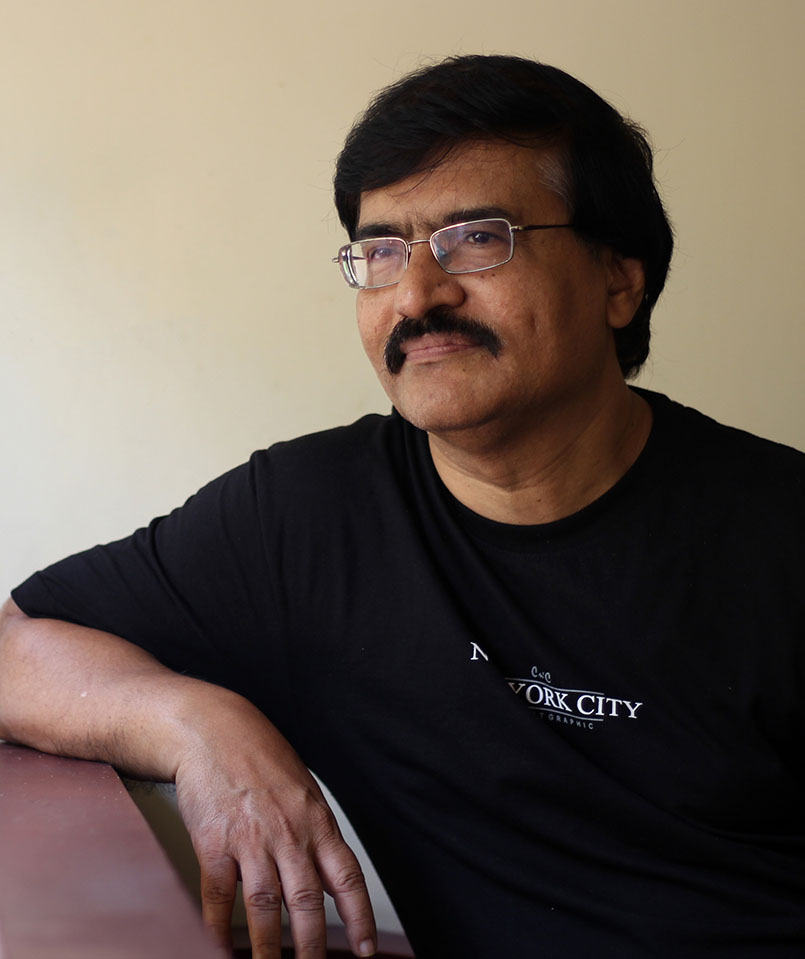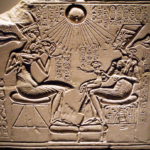“I see in the near future a crisis approaching that unnerves me and causes me to tremble for the safety of my country. . . . corporations have been enthroned and an era of corruption in high places will follow, and the money power of the country will endeavour to prolong its reign by working upon the prejudices of the people until all wealth is aggregated in a few hands and the Republic is destroyed.”
– Abraham Lincoln

“Auditor should be conscious of the fact that he is reviewing a decision that has already been taken…He does not have to sensationalize. He doesn’t have to get into the headlines.” Thus spake Sri Arun Jaitley, India’s Finance Minister, while addressing the annual conference of the Comptroller and Auditor General (CAG) of India at New Delhi on 29.10.2014. “… let us also not forget that when we live in a society, which by temperament…has become an over suspicious society… our job is not to convert the public opinion into a kind of a lynch mob,” he continued. Yes. The auditor does not have to create sensations, grab headlines, or produce lynch mobs. The thought is right and its articulation attractive.
But, how come such thoughts never occurred to the Hon Minister while he was in the opposition. For instance, wasn’t the CAG sensationalizing and seeking to grab headlines when he summoned a media crowd and used PowerPoint presentations to ‘expose and explain’ how the then government was taking the country to the cleaners? Again, wasn’t the CAG creating the myth of ‘presumptive’ losses of galactic proportions to convert the public opinion into a kind of lynch mob? Entire Parliament sessions were washed out. Critical legislations remained hanging fire. Yet, the nation heard no such sage advises from the political opposition of the time. It saw nothing but high spirits and higher euphoria in the opposition camps.
But scams and scandals are not the staple diet of the opposition alone. The media craves for it. And the CAG bestowed upon them a ‘coalmine’ of it. The whole nation went gaga about the CAG reports. TV channels went on a ‘Breaking News’ spree. Anchors went overboard vying with one another in yelling to break the sound barrier. All opposing opinions were pooh-poohed and dinned out. The CAG became the darling of the media and the political opposition. People were made to see a halo of holiness around the noble head of the CAG. The citizens sang ‘Hosanna’ to see that their Messiah had arrived at last to save them from the quagmire of corruption into which the nation was sinking!
The anti-graft apostles made merry of the event and screamed themselves hoarse. ‘The nation wants to know’, the media yelled in unison. The Annas, the Babas and all and sundry held big ticket theatrics occupying all available roads, open spaces and TV slots. All hell broke loose. Rumours were fuelled. Anarchy ruled. And an undraped (UPA) Sarkar scurried for cover. Several heads rolled. Many a high and mighty went behind the bars…
The 2G report was only a curtain raiser. The CAG continued to produce more audit reports to ensure an unceasing flow of explosive scam fodder to a sensation-hungry nation that gobbled up everything. There were facts. And there was fiction. There was hype. And there was hoopla. The heady mix churned out titillating tales. The numbers involved were mind-boggling. The nation was shocked and hooked. The half-hearted official defence of ‘compulsions of coalition politics’ did not wash. The regime floundered. Eventually it fell. “And great was its collapse.”
There appeared an avalanche of stories in the aftermath of the exposure of the 2G scam. While earlier stories continued in circulation, fresh stories were being minted each day. There is truth in every story. There is also blatant sensationalism and unmitigated lies in it. The wheat and the chaff remain inextricably mixed. To separate it is not easy. My attempt here is to enlighten the non-expert reader on the so called 2G Scam…
What is 2G? Wireless telephone technologies are named with reference to its technology levels as 1st Generation (1G), 2nd Generation (2G) etc. The First Generation, or 1G mobile networks came into operation in the 1970s. 1G signals were based on analogue technology. In the early 1990s, 2G phones deploying Global System for Mobile communications (GSM) technology were introduced. GSM used digital modulation to improve voice quality. Its data carrying capabilities were limited. Mobile telecom technology has since progressed beyond 2G to 3G, 4G and 5G with focus shifted towards better data and video carrying capabilities. However, the bulk of India’s mobile telecom system is still on the 2G GSM technology since our mobile phones are used primarily for voice communications.
The radio frequencies used in mobile communications are considered the property of the state. Unique ranges of these radio waves are allotted by the state to the telecom service providers who utilize it for providing mobile phone connections. These radio frequencies are known as ‘wireless spectrum’ or just ‘Spectrum’. Every mobile telecom service provider must have its quota of spectrum to operate the service.
Mobile telecom services remained unaffordable to most Indians when the network was small. As the system expanded and the number of connections grew, tariffs dropped. This in turn spiked the demand for new mobile phone connections. In order to cater to the swelling demand, in 2007, the government of India proposed to give spectrum licenses to eight new companies. It took a policy decision to allocate licenses at prices fixed in 2001. The licenses were to be allotted to telecom companies on a ‘first-come-first-served’ basis. The proposal was announced. The cut-off date for application for spectrum licences was fixed as 01.10.2007. And thereby begins the 2G saga.
Had the allocation went ahead as per the original plans, there would have been no scam stories to report. But this was not to be. In a sudden and surprising move, one fine morning the Department of Telecommunication preponed the cut-off date from 01 October 2007 to 25 September 2007. As if that was not effrontery enough, later on the same day, DoT posted another announcement on its website seeking the 2G spectrum applicants to complete the required formalities and make the requisite payments (in the form of bank drafts) between 3:30 and 4:30 pm on that very day.
The ‘first come first served’ policy was put to death. The one-hour window for completing formalities sealed its fate. People, who had insider knowledge about the impending announcement, were ready days before its actual appearance. They cornered the licenses. For the rest, compliance was practically impossible. They went home empty handed. Thus, companies like Unitech and Swan Telecom, who were never in the telecom business, were issued licenses. They made a killing out of the bonanza. For instance, Swan Telecom was issued licences for Rs.1,537 crore. They offloaded 45% of their shares to UAE based Etisalat for Rs.4,500 crore. Similarly, Unitech Wireless bagged licenses for Rs. 1661 Crore and sold 60% of its stake for Rs.6,200 crore to the Norway-based company Telenor. Huge sums changed hands under innumerable layers of dubious deals…
But the delight of the deceivers was short-lived. Enter the Comptroller and Auditor General (CAG) of India – the nation’s auditor. CAG is a constitutional authority and the guardian of the public purse. CAG examines all transactions to see whether public money is spent with due authorization and for bona fide purposes. CAG also examines the receipts for the right assessment, collection and allocation of the revenues. CAG audits the accounts of Central and State governments, and other entities. He submits audit reports to the President of India or the Governor of the State concerned, as the case may be, who in turn causes his report to be placed before the appropriate legislature. The report is examined and acted upon by the Public Accounts Committee (PAC), of the legislature concerned.
The CAG audited the transactions of the Department of Telecommunications covering the 2G spectrum licensing process. He discovered serious anomalies and inconsistencies in the processes followed and decisions made and altered. CAG smelled a rat and tried to ferret it out into the open. The report that came out exposed the wheeling and dealing that went behind the curtain. The nation was shocked. The government was laid on the chopping block. Media went berserk. The political opposition screamed for the government’s blood. The telecom minister was made to put in his papers. He and many others were arrested and sent to jail. The matter is now in the courts… (The verdict has since been delivered by the trial court which acquitted all the accused).
That was the crux of the 2G scam. But the story did not end with just the discovery of the swindle and its followup by the appropriate authorities. The issue of loss to the public exchequer continued to smoulder. I find it difficult to swallow the assumption of the CAG that everyone involved in the decision chain of 2G spectrum sales was a dumbhead or a damned crook out to make a fast buck. There must have been at least a few honest people clearing the proposal in good faith. There must have been cogent reasons for keeping spectrum prices low at 2001 rates. A brief peep into the history of Indian Telecom covering the last two decades might shed some light on this thought.
In 1994 when Indian policy makers were considering a National Telecom Policy (NTP), India had just 80 lakh telephone connections. The waiting list for telephone connection stood at 25 lakh. The tele-density (Number of phone connections per 100 population) was 0.8. Telecom service was a governmental monopoly. The waiting period for connection ranged from a few years to a few decades.
NTP 1994 emerged as part of the Liberalization, Privatization, Globalization (LPG) policies introduced in 1991 by the Government under the leadership of Sri Narasimha Rao with Dr Manmohan Singh as the Finance Minister. The focus of the policy was “telecommunication for all and telecommunication within the reach of all”. A conducive environment of telecom investment was created. The Government monopoly over telecom was ended and the sector was opened up for private players.
NTP-1994 policy was reviewed and revised in 1999 “…to achieve an overall tele-density of 15 by the year 2010 and an Increase in the rural tele-density from the level of 0.4 to 4 by the year 2010.” The policy triggered a dream run for the Indian telecom industry.
I hate to burden the reader with ho-hum statistics. But just to give an idea on the speed with which our telecom system grew, it is essential to present a couple of figures. India had less than 1 core telephone connections in 1994. As on 31.08.2014, we had 95 crore connections. That is almost a hundred-fold increase in just twenty years! The overall tele-density was less than one in 1994 and a poor four in 2001. It stood at 76.36 on 31.08.2014. The tele-density did not grow evenly. It remained high in urban areas and low in rural areas.
What was the secret behind India’s amazing telecom growth? Of course, the policies facilitated investment in the sector. But affordability was the most critical factor. The low telecom tariff structure of India made the service affordable to all. In order to ensure growth of the sector, it was imperative to keep tariffs low without driving the telecom companies bankrupt. I believe that the government decision to allot spectrum in 2007 at the rates fixed in 2001 should be viewed in this context. The choice before the government was to either opt for a ‘Revenue Maximization’ model or a ‘Welfare Maximization’ model. Government could auction the Spectrum and earn maximum revenue in the short run. In that case tariff would rule high and Service Providers would stay focused on the urban areas to survive. On the other hand, the government could keep the Spectrum prices low and allow Service Providers the financial potential to stay afloat and expand their sphere of operation into rural areas. The government chose the latter option. It is not easy to fault the government for it.
As Sri Jaitley put it, “…we leave some element of benefit of doubt for a decision where two possible views are possible. But we can always lay down the guidelines as far as the future is concerned.” I find no reasons to disagree with Sri Jaitley. But the CAG had a different take. He had no desire to limit himself to such mundane levels. The CAG apparently held the skewed view that an elected government had no prerogative to decide its policies. The CAG alone knew what was in the best interest of the nation! So, the CAG went ahead and quantified the, so called, ‘presumptive loss’ taking three different routes and arriving at three different figures. The lowest of these was Rs.57,666 crore and the highest Rs.1.76 lakh crore. The smaller figures were not seductive enough for the media or the political opposition. So everyone clambered to grab the astronomical sum of Rs.1.76 lakh crore – a fraud figure unheard of in the history of India. The pyrotechnics that followed rocked the nation…
“Rs 1.76 lakh crore in 2007 was 4.4 per cent of India’s GDP; it was a couple of billion dollars more than twice our entire defence budget for that year. Now think, could the value of a little bit of spectrum be that much? Could India’s telecom sector have paid that kind of money for it? And if so, why didn’t you simply abolish the defence budget and ask the armed forces to auction little bits of the spectrum they hoard every year and buy all the guns, submarines and jets they need? India’s telecom growth has been held to ransom by that mythology…”, wrote Shekhar Gupta, the renowned journalist, on 30.10.2014.
The question is whether it was the right thing for the government to allot the spectrum to the highest bidder at unsustainable prices and thereby push the telecom tariffs up or bring the telecom companies down and thwart the country’s telecom growth and its even development. Incidentally, the same way, the price of coal impacts a range of sectors that depend up on coal like power, steel, cement, fertilizers etc. The question again is whether it would be the best approach for the government to rake in extra moolah in the short-run and end up ruining the nation’s economy in the long-run. Extending the argument, should the government auction water and air since these too are purportedly government assets. (It is a positive development that the Hon Supreme Court of India had reviewed and clarified the position on this subsequently.)
What was the aftermath of the astronomical figures conjured up by the CAG? The Hon. Supreme Court of India ordered the cancellation of 122 2G spectrum licenses, although the allegations of fraud were confined to a much smaller number of licenses. India’s telecom growth was held to ransom on the strength of a myth. One of the judges who adjudicated the matter retired and went home for good the same day, after delivering the verdict. Certainly, he was a judge in a hurry… A few months down the line, the Hon. Supreme Court cancelled 218 plus coalmine allocations, seriously jeopardising a string of critical sectors. Banks that had given huge loans to the affected companies have been left with staggering levels of Non-performing Assets (NPA).
It is nobody’s case that we should overlook corruption. But the hype generated on the strength of imaginary numbers carrying innumerable zeros cannot be allowed to pull down the progress of a nation. The wholesale reversal of government decisions by law courts is neither good economics nor good politics. If people are afraid to invest in India, part of their fears is associated with the mindless activism of certain constitutional authorities. As the Honorable Union Minister said, “…people are scared to take decision for dangers of a future review. This is an experience where in meeting after meeting, observation after observation, a tendency to pass the buck so that decisions are not taken during my period because decision could be adversely commented…the system has to continue to function.”
The predilections of the auditor notwithstanding, the fact remains that the telecom sector provides employment to millions and has helped the nation’s progress in virtually every field – IT and ITES, education, banking, health care, e-commerce, call centres, offshoring…. The annual telecom revenue figure that stood at Rs.12,900 crore in 2008 has touched Rs.200,000 crore now (2014). Government should be earning over Rs.24,000/- crore annually as Service Tax alone on this revenue (at 2014 rates which has since been raised). Corporate tax, personal income tax etc. are other revenue avenues for the state. So, should we fault the government for doing its bit to keep the sector growing by retaining input prices low? Should elected governments kill the goose that lays the golden egg for the simple reason that some ‘constitutional authority’ so fancies?
And finally, what exactly was the 2G scam? It was that companies that were not in the telecom business and companies that existed only on paper received spectrum licenses. But it was denied to bona fide telecom companies, which had waited for long for licenses. The entire licensing process smacked of nepotism, favouritism and crony capitalism. The unholy nexus of politicians, bureaucrats and corporates won, albeit temporarily. The fraudsters and their cronies minted money. The nation was taken for a ride. This was the essential 2G fraud, straight and simple. The rest is all unmitigated myths.
You do not agree? Well. I respect your right to disagree.
PS
May be, the skeptics might do some re-thinking, considering the 2G verdict delivered by the trial court on 21 Dec 2017. The verdict, inter alia, says, “Some people created a scam by artfully arranging a few selected facts and exaggerating things beyond recognition to astronomical levels.” It also says, “Vested interests manipulated public perception by leveraging the media and sensationalising allegations. It has been repeatedly proven that the presumptive loss to the exchequer which formed the basis for the conspiracy theorists to run amok was cooked up.” Of course, the last word on the 2G Scam has not been said. Let us see what happens next.
(This post written on 7 Nov 2014 has been updated on 28 Dec 2017 in the light of the trial court verdict)
————————












First a correction the Bench adjudicating the 2G case comprised of Justice(s) A K Ganguly and A K Singhvi neither of who have graced the Office of CJI. Justice A K Ganguly was the one who retired on the same day as he delivered the Justice and became (in) famous later for certain other reasons which is still subjudice. Now the eponymous 2G figures as reported by the CAG- while it may be true that the figures may be pure mathematics but certainly not a wild guess. The CAG had its reasons to believe that the presumptive loss figures it was providing were correct and explained the rationale too. However in India as it always happens we keep on going around beating the bush! Else would the GoI not learnt a lesson from the 2G , the PM not questioned the Minister and Ministers or for that sake the all of GoI given a 'license' to go bag & baggage slamming the CAG. Every body was so busy hammering the CAG that no body ever noticed an even bigger SCAM of how the STATE cheated its own ENTERPRISE of billions by forcefully allotting the spectrum in all Telecom Circles and in some cases below par Airwaves at the cost equivalent to the Highest Bid and not allowing it to borrow from any Financial Institution which all others did(The old maxim goes Loaned capital is more remunerative than the Owned Capital). And what was this if not causing an otherwise healthy organization to die. Not even the CAG questioned this. But the fact remains that if the figures would not have been what they were no body repeat none would have taken care to put their attention to what became known as 2G Scam. And to that extent you stand vindicated! FIGURES CREATED NOISE! adarsh
Dear Adarsh,
I thank you for your comments and for bringing the error in this post to my attention. I should have verified the facts rather than bank entirely on my memory. Yes. The judge who retired was not the CJI. I stand corrected.
Incidentally, as a matter of policy, I do not mention names in my posts, as far as possible.
Coming to the other point, let me clarify that my problem with the CAG is that he was trying to dictate policy to an elected government. CAG could have expressed his views and issued necessary guidelines for the future. CAG or even the Supreme Court has no right to interfere in government policies and the Hon SC has already confirmed this position more than once, the latest, that came to my notice, being the case related to caste based surveys. The courts can step in only in the case of laws and policies that are constitutionally invalid. (I may try to elaborate this understanding in a future post). If the government policy was wrong, the place to challenge it is the parliament. It would be dangerous for any democracy to allow any other authority irrespective of its relevance or eminence to appropriate the authority of an elected government and the legislature. This is my belief. It is possible that I am wrong.
Regards,
kutty